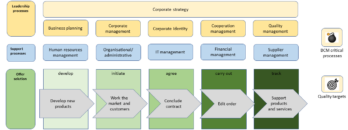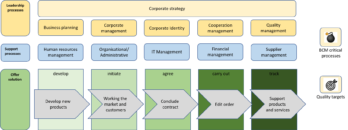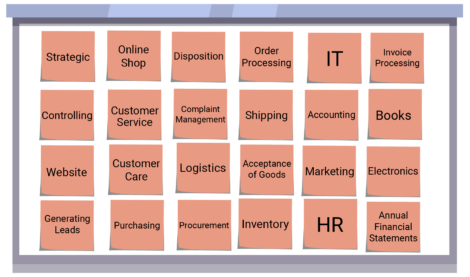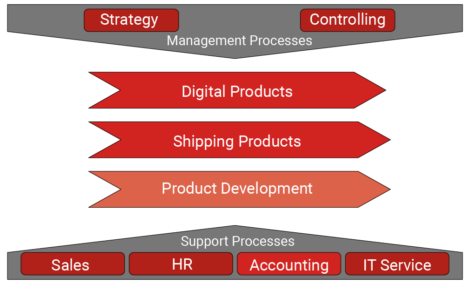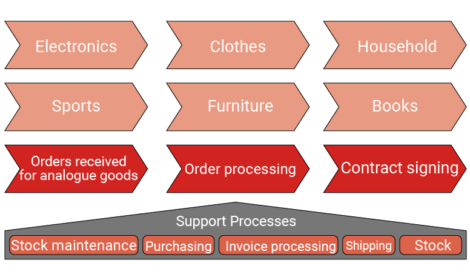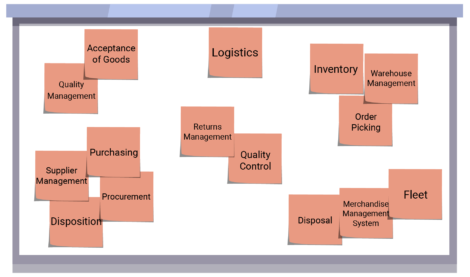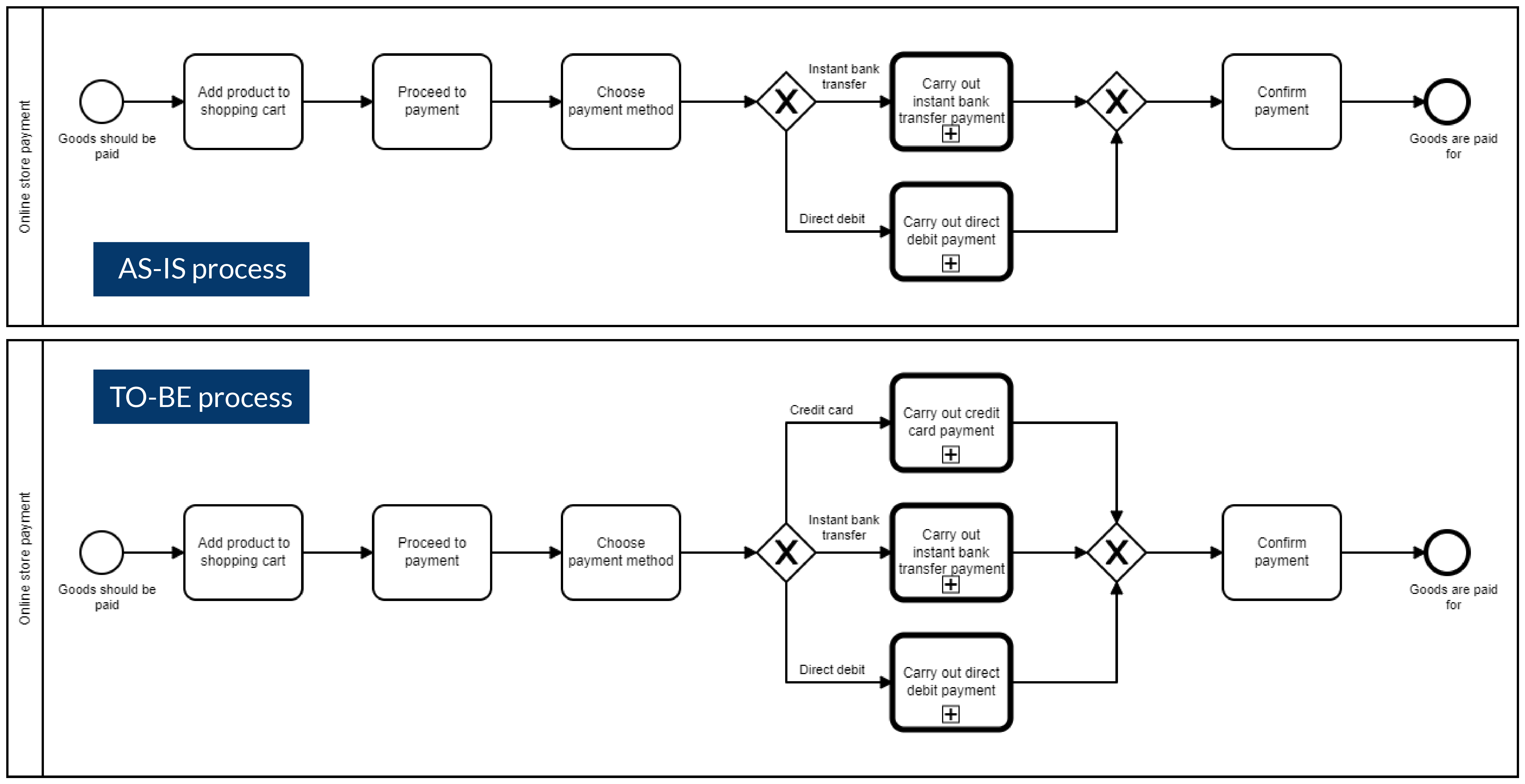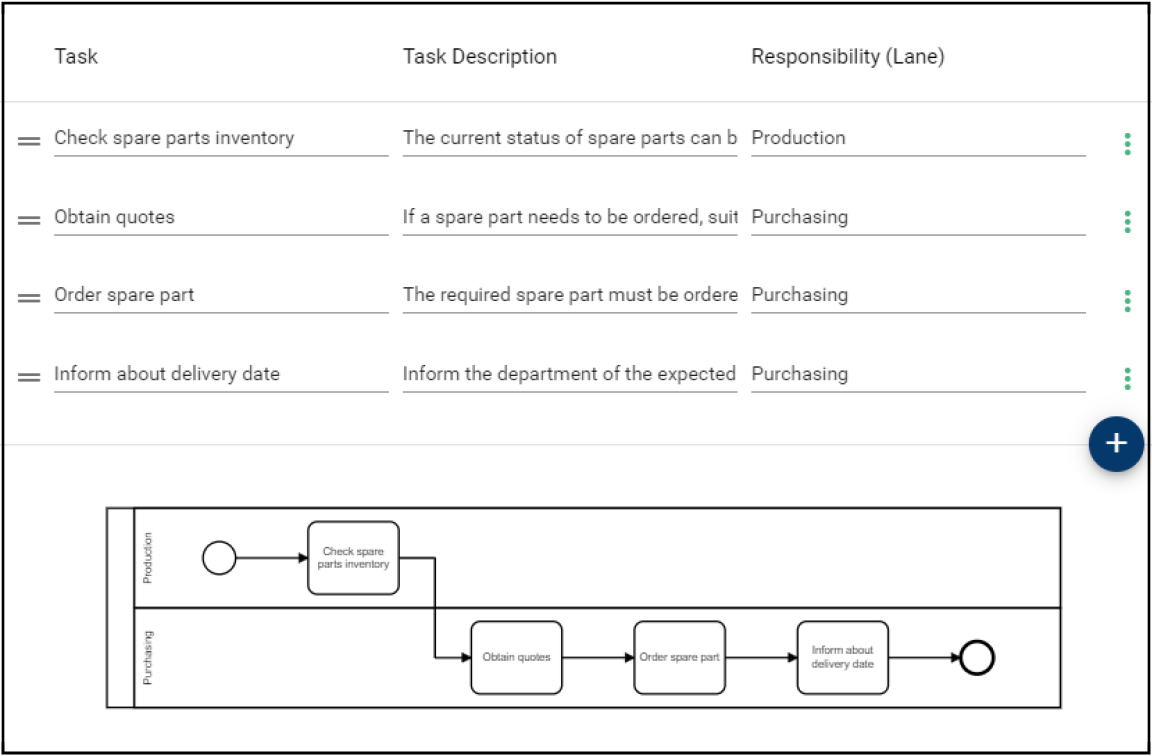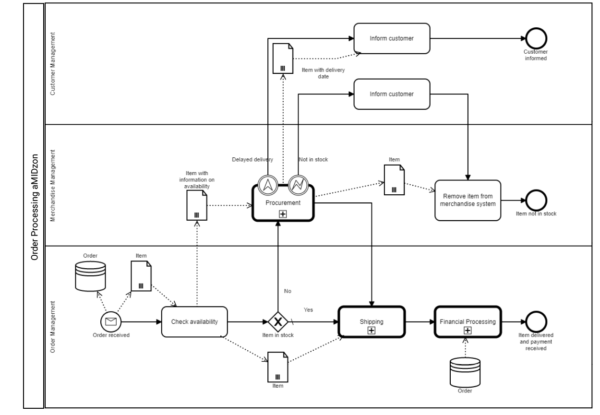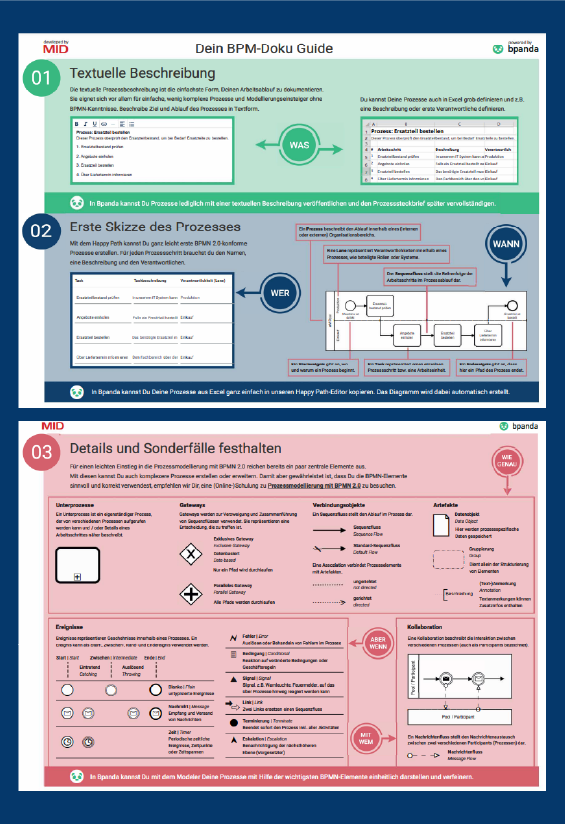Easily Introduce Process Management in Your Company Using the 6 Main W’s
Follow Wolfgang on his journey introducing process management within his company. Join him live as he finds his path to success!

aMIDzon distributes private goods in Central Europe. The company has reacted to changes in the market and made several recent changes.
Challenges
• International competition
• Continuous change / growth
• Cross-divisional workflows
• Increasing costs (storage, employees)
• Resources for employee onboarding

Wolfgang has been a dedicated aMIDzon employee for many years. He is responsible for receiving goods, storage and just-in-time processes.
Challenges
• Coordinate logistic processes
• Transition to digital warehouse
• Handling complaints
• No overview of employees
• Legal & internal requirements
Wolfgang’s story starts with problems that you are also probably familiar with: Confusing flows, inefficiency, lack of transparency, discontent and high error rates are just some of the challenges Wolfgang faces. Find out from Wolfgang why process management is the answer to all his troubles in this video.
We will use Wolfgang and aMIDzon to show you how you can successfully introduce process management into your company using just six questions.
Let’s go!

WHAT do I Need Process Management for?
You should start by finding out about process management and define what you hope to achieve by introducing it within your company. Each company has their own personal process management aims. These aims may also change over time depending on the industry or current challenges. As well as the company-specific aims, there are also a few basic aspects you should aim to achieve when striving for a well-oiled process management. We’ll tell you what these are in our video.
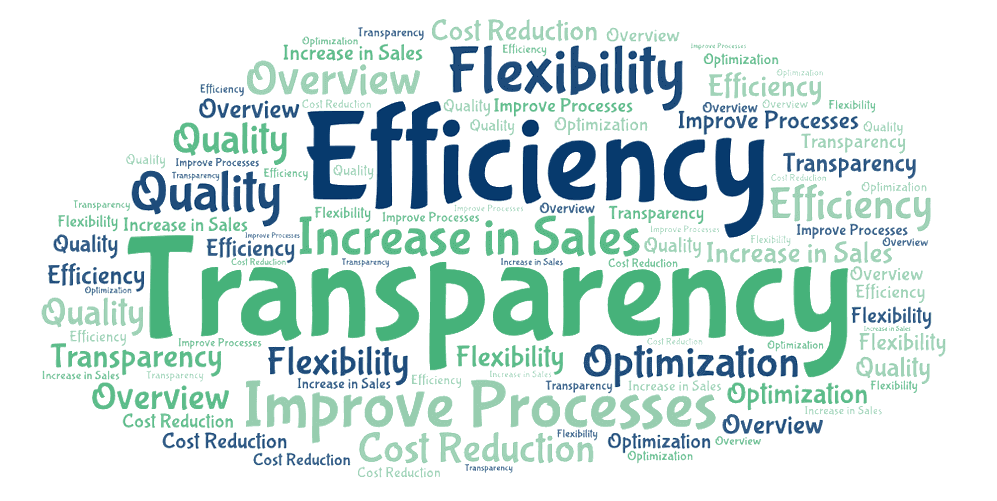
As you know, Wolfgang has shipment issues. Customers complain about long delivery times and are dissatisfied. Wolfgang would like to introduce process management within the company to shorten delivery times and improve complaint rates.
He sets himself the following aims:
- Shorten delivery times by 10% within a year
- Reduce complaint rates by 10% within a year
The managing directors have also set Wolfgang two further goals:
- Sales growth of 3% over the next 3 years
- Cut costs by 3% by the end of the year

WHAT do I Need for Successful Introduction?
Unfortunately, process management often runs into difficulties right from the very beginning due to unrealistic time and budget resources for the project, insufficient communication or the number of people involved in the project is either too many or not enough. You should take these three points into account when introducing process management into your company:
Ensure that your managing directors are behind process management 100% and will provide you with the necessary resources. Process management should also be sold as a great opportunity for all employees and not as a burden for a few singled out for this task.
Start small and then increase the team as the rollout gathers speed. You should include the managing directors in the team, as well as department heads
(= process owners). It is also important to include those who are directly involved in the workflow itself (= process users).
Instead of compiling documentation using Excel & Visio, you should invest in a professional process management tool. Find out which functions different tools provide and make your choice of software based on what best suits your aims and challenges.
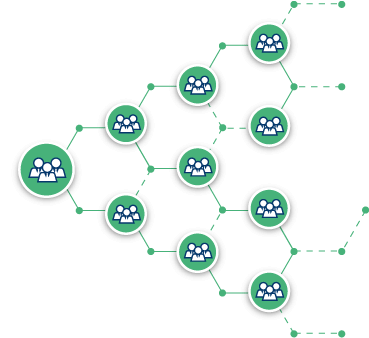
Wolfgang wants process management to be a success for aMIDzon, which is why he spoke to managing director, Christian Lange, about it in good time. Despite initial resistance due to time and money constraints, Wolfgang managed to convince the managing director about his project and has been given the go ahead to source the appropriate software for aMIDzon. The new tool should be web-based, user-friendly and collaborative. After extensive research, Wolfgang has decided to use MID GmbH’s Bpanda.
He now has to think how best to put together his project team and downloads MID GmbH’s skill matrix for this.
How to Successfully Introduce Process Management Together with your Employees and Colleagues

OFFICIAL GO
OK given by management for budget & time resources.


DEFINE MULTIPLIERS
Start with suitable selected people.


BROADEN KNOWLEDGE
Ensure that all of those involved know how to proceed. Enable them to participate in process management and BPMN 2.0 training.


FORM TANDEMS
Use the knowledge of your multipliers to add to those involved within the project and show them the processes.
Wolfgang decides to start off with a small circle of people; they will then act as multipliers who should pass their knowledge on to other colleagues. As the current problems faced by aMIDzon lie primarily in the accounts, dispatch and order processing departments, Wolfgang decides to add the heads of these departments to his project team.

Andrea is in charge of figures in the company and takes care of invoices for suppliers and colleagues. Digitalization is easy as pie for her.
Skills:
• Maths whiz
• Assertive
• Time management skills

Jürgen always puts the customers first. He is responsible for making sure customers get their undamaged products they ordered within good time.
Skills:
• Team player
• Contacts within the company
• Customer-oriented
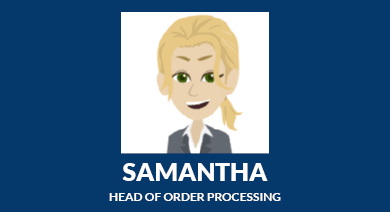
Samantha is aMIDzon’s organizational talent. She controls important flows such as purchase transactions and cancellations.
Skills:
• Communicative
• Project management
• Understands processes

WHAT do I Need to Get Started?
Once you have sorted the strategic aspects of introduction, then you’ll probably want to get cracking and start documenting your first processes with your software. Make sure you take the time before you rush into it and set a few rules and boundaries within your core team so that documentation will be standardized. Use a methods manual for this, i.e. an internal guideline to help foster a common understanding of process management within your company.
Methods Manual
This is a document which contains the entire business process management plans for your company. Use this manual to set guidelines, aims and methodical considerations to be made about introduction of process management. You should also define important terms so that everyone has a common understanding. You can also define to what extent the processes should be documented. To do this, define conventions and elements for modeling, from the process landscape (incl. levels) right through to the process element. You should also make sure you define information about the roles within process management as well as information about your process management software.
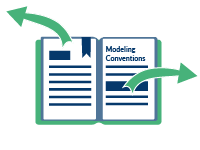
Modeling Conventions
These are an important part of the methods manual, as you use them to define all standards for modeling your processes. This ensures uniform documentation and not a case of everyone doing what they think is best. Define the modeling direction here (e.g. classic from left to right) and how processes or process steps should be named (e.g. noun + verb). You should also set which elements are allowed in which process levels.
It might also be helpful to get some support for a smooth operational rollout of your process management. The company providing the process management software you purchased often has additional introduction packages for process management. These might be workshops, training for software & BPMN 2.0 methodology, process consultancy or process migration.
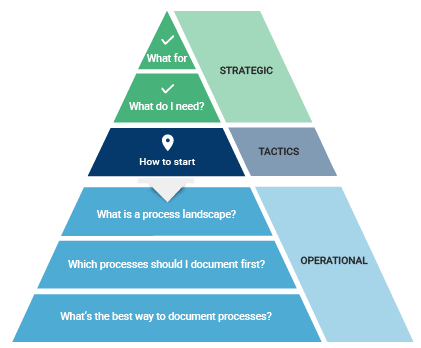
Wolfgang can’t wait to finally get started with process management. Uniform documentation of processes is important to him, so the first thing he wants to do is to get all the important information down in a methods manual.
To do this, he’s getting some help from the experts at MID GmbH. He uses his “Base Rules” module for this that was included in his introduction package for process management when he bought his Bpanda licenses.
After completing a successful workshop with his core team, Wolfgang has clearly defined the following aspects in a methods manual (excerpt):
aMIDzon processes should be hierarchically documented in four levels.
Level 0
Overview of the entire company, including management, core and support processes
Level 1
Relationship between business processes
Level 2
Business processes
Level 3
Subprocesses
Level 0
Overview of the entire company, including management, core and support processes
Level 1
Relationship between business processes
Level 2
Business processes
Level 3
Subprocesses
They have also defined that the roles BPM manager, process designer, process owner, process participant and process user should be used. Modeling will be left to right, in accordance with the software, Bpanda. Processes always need to be a noun (e.g. order processing) and process steps always need to contain at least one verb (e.g. process invoice). Each process must also start with a trigger and end with a result.

WHAT is a Process Landscape?
Methods manual – tick! Let’s get cracking! You can now go ahead and become operational with process management. The first step is to create a process landscape for your company. What is that exactly? Basically, your process landscape contains all of your company processes and structures them using process maps and various levels (level 0 to level xx). Your processes are put into a hierarchical order which determines your process hierarchy.
The process landscape contains various linked process maps. A process map is a visual representation of your processes; each level is grouped by topic. It shows you how individual processes are linked with one another. Level 0 of the process map shows you e.g. the most compact overview and normally depicts your management, core and support processes. Use it as a kind of navigation help where you can easily drill down into subprocesses.
The following video will show you how the process landscape, process maps and levels all link together.
Creating a process landscape takes a bit of thought but it is super important for becoming a process-oriented company. It’s a good idea to invest a bit of time in this together with your core team and managing directors. Determining management, core and support processes affects all areas of the company, so it is important to make sure you are particularly structured and methodical.
You get to decide exactly how your process landscape should look. Some process management tools allow you to create process maps directly in the software, whereas others allow you to import the maps as images. There isn’t generally a right or wrong way when deciding what your process landscape should look like. After all, each company is individual and so is their process landscape. Below, you can see three examples of how different process landscapes can look like:
Wolfgang now has the task of hierarchically depicting aMIDzon’s processes in process maps. He knows it’s an important step to rolling out process management within his company and wants some help on the matter as he’s never created a process map before. He asks Katja, process consultant at MID GmbH, how he should best go about creating a process landscape.
She recommends taking a four-pronged approach: 1. Brainstorming, 2. Clustering, 3. Map level 0 of the process map, 4. Map process maps below this.
Step 1: Brainstorming
This is how Wolfgang wants things to go. He organizes a meeting with his core team and managing director, Christian Lange, so that they can discuss what processes exist in aMIDzon. They use existing Word and Excel documents for this which already contain some aMIDzon flows. During the brainstorming they think of other processes which have not been documented yet. Wolfgang makes a note of each process on a post-it and sticks them all on a whiteboard. The five people in the meeting can’t believe how full the whiteboard has become by the end of the meeting.
Step 2: Clustering Processes
Wolfgang now wants to divide the processes into management, core and support processes. He starts off by explaining the differences between these three process types to the others:
- Management processes (MP) are all value-creating processes which determine the strategic direction aMIDzon should take.
- Core processes (CP) on the other hand are value-adding processes which earn aMIDzon money.
- Support processes (SP) contain processes which ensure value and that things run smoothly at aMIDzon.
Wolfgang then divides his whiteboard into these three areas and they discuss which process belongs in which. Wolfgang makes sure that the clustering takes place according to the processes and doesn’t call the importance of (support) areas into question. Once they are finished, they have not only split the board into three areas, but have also hierarchically stuck the first processes below one another. Wolfgang knows that there are probably more processes which take place in aMIDzon, but it’s a good starting point.
Click to Zoom
Step 3: Depict Level 0 of the Process Map
It’s done and Wolfgang is delighted with the outcome of the brainstorming. It might have taken a bit longer than they originally thought, but it was all worth it. Everyone offered their opinions and worked together to ensure transparency. Andrea, Jürgen, Samantha and even Christian Lange have all learned a thing or two about the other departments and how the processes all fit together within the company. A win-win situation for everyone!
Wolfgang now gets to work with creating aMIDzon’s level 0 process map in Bpanda. He decides to put the management processes at the top and support processes at the bottom. All core processes come in the middle of the process map. Wolfgang then proudly shows off his first process map, which is a compact overview of aMIDzon’s process landscape. He publishes it directly in Bpanda so that his core team can also see it.
Click to Zoom
Click to Zoom
Step 4: Add Process Maps Below
Now he has the top-most process map, Wolfgang takes another look at the brainstorming and clustering results. He sees that he can only create one or two process maps for level 1 of the aMIDzon process hierarchy. He knows which processes belong to which area thanks to sorting the post-its into a hierarchical order. But he doesn’t know exactly what happens in the processes and subprocesses as he only has the process names written on the post-its. The process landscape won’t be complete until the processes (level 2) and subprocesses (level 3) are depicted with the individual steps (from W6).
Wolfgang shows his team what he’s done so far and reminds them that these process maps are version 1 as things stand. As process management is a new thing in the company, any additional processes added to the map are simply a further piece of the puzzle in making up the overall picture of what processes take place in aMIDzon. The process map comes alive and helps Wolfgang to rollout process management within the company. This is merely the first version; there will be many more to come. This is the only way to keep process documentation up-to-date and current.

WHICH Processes should I Document First?
Creating your process map has also given you a selection of processes that can be documented. Now you have to decide which processes you should start with. All processes are important – we know! That doesn’t make the decision any easier but you can’t document them all at once. You need to focus on one thing so you don’t get yourself in a pickle and waste time you don’t have. Here’s our handy hint: Identify a few critical processes and start with these. There are different approaches to decide which processes these are for you.

We’re sure you can think of a few top candidates when it comes to processes that always cause problems and never run smoothly. Maybe certain flows or process steps have changed, including who is in charge of them, and not everyone is aware of these changes? These processes will never be able to run smoothly if people don’t know about them. These problem children are often the processes which need to be carried out as a matter of urgency. If this is one of the reasons why you want to rollout process management within your company, then you should start by documenting these processes.

Critical processes could also be those that always cause lots of discussions. They are always sluggish and never happen on time. This is annoying for both employees and customers alike. Customer satisfaction is low and customer complaints high, which is obviously bad for business. The same can happen with processes where lots of different people or departments are involved. If collaboration and handing over of process steps do not run smoothly, then this often leads to unnecessary delays and uncertainties. Departments often blame other departments. These processes should also be top of your list.
Get together with your core team. It’s really important to speak to both sides in this phase, so with both the process owners and those who actually carry out the process. This is the only way to get a realistic idea of which processes currently have issues and allows you to make good decisions.
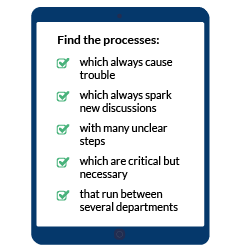
Wolfgang also has a think about how he wants to proceed. He can think of a few processes that are currently causing issues. There have been so many changes recently at aMIDzon: introducing online shops, an additional site, different warehouse locations for physical products and a rise in customer complaints. The more he thinks about it, the more processes he adds to his absolute top priority list. Sometimes he thinks he should start with the processes that have changed, and sometimes he thinks he should start with long-standing processes which run badly. Not an easy decision to make.
This isn’t getting Wolfgang anywhere. All he has now is a massive long list of processes he could tackle but he still doesn’t know which one to start with first. Have a look what he did to decide which four aMIDzon processes to document first.

WHAT’S the Best Way to Document Processes in Bpanda?
So, now you know which processes you want to start with. But now you need 2 other things before you can get going with successfully documenting this and all subsequent processes in your company: 1. The ability to document processes and 2. The knowledge of what the process looks like.
1. The Ability to Document Processes
Of course there is more than one way to document processes. In fact, there are loads of way – from everyday tools, such as Visio, Excel and Word, right through to modeling languages, such as EPK or BPMN 2.0. It’s up to you to choose which way is the right one for you.
We recommend using BPMN 2.0 (Business Process Model and Notation)!
BPMN 2.0 is the current industry standard for graphic depiction of business processes and is supported by practically every modern process management software. Why should you document your processes with BPMN 2.0? There are three obvious advantages:
BPMN 2.0 consists of a certain number of expressive elements. The process will always be displayed in the same way as everyone uses the same elements when documenting. This common language brings with it clear rules and less freedom to simply do what you think or misinterpretations.
This enables you to establish one common and transparent documentation.
Graphic depiction using BPMN 2.0 makes it much easier for employees with no previous process management experience to “read” and understand the processes. Information is stored together in one place and no one has to look through two lists and three more Word documents to find all the information.
More and more companies are favoring BPMN 2.0 as their process language of choice. Why not profit from best practices too? This process language is based on BPMN XML format; you can use it for both exchange with other process management tools and process automation at a later stage.
Check out our BPMN 2.0 poster for a great overview of all elements.
Watch out: You can’t just simply select an element and put it wherever you want. The same applies for handy notification checks which many process management tools have integrated in them. They do work like a spell check to show you what errors you have made when modeling with BPMN, but just as when writing in a foreign language, they cannot replace missing BPMN language skills.
You need to know which element should be introduced in which situation and be able to create the correct context between elements when using BPMN. The best way to learn all this is via one of our professional training. Why not sign up for e.g. a course focused on process modeling in BPMN 2 for you and your core team? It will help you get to grips with the different elements and how to put them into practice. If you want to introduce process management within your company, then you should probably understand it first. Your colleagues and superiors won’t take you seriously if you don’t know what you’re talking about and you’ll struggle to convince them about the advantages of becoming a process-oriented company.
2. Knowledge of What the Process Looks Like
Once you know your stuff with BPMN 2.0, then you need to find out how the processes you want to document actually run, i.e. what steps is it made up of and who is responsible for each step. This is called process investigation or process entry. You need to talk with both the people who are responsible for the processes and also those who actually carry it out. Hold a process interview where you discuss how the process actually runs instead of requesting a written document from each participant. Active communication in a group is the best way to get a real picture of how the process runs. Otherwise you run the danger of receiving 10 different versions of a process and having to work out which one is actually the right one. Before conducting the process interview, you should ensure that everyone knows what the aim of the meeting is and ask them to prepare for it. This will make the discussion more targeted and specific.
You can bring any existing process documentation to the meeting, even if it’s only a few lists or simple process descriptions. You should also decide at the beginning whether you want to find out the actual status of the process as it stands or the ideal process. It is often easier to start with the current status and document this. This is quicker and helps you to spot the missing transparency. Once you have done this, then you can set about changing and improving the process to reflect the ideal.
1+2=3. Document the Process
You can now get started using various BPMN elements in your process management software to document the first process. Don’t worry, you can start slowly and build up from a simple written process description to a detailed modeled process. Depending on how complex the process is and how many people are involved, it might be a good idea to tackle the process documentation iteratively and map the so-called happy path first.
The happy path is the simplest, most direct route for a process, not including branching or exceptions, i.e. the foundations of the process. This foundation should contain the following three pieces of information: Title, description and who is responsible for each process step. This is enough information to get started with mapping your process graphically using process steps (tasks) and areas of responsibility (lanes) – the perfect groundwork for adding detailed BPMN elements such as gateways and events to.
After a successful workshop, Wolfgang can’t wait to get started documenting the first process. His process management software, Bpanda, has three ways to get going which all build on one another.
- Wolfgang can only describe processes in written form. Process details are automatically created for each process; he can then add information such as who is responsible for the process or attachments.
- He can use the happy path to add a title, description and those responsible for the process to easily form the foundations of the process.
- Wolfgang can then use the Modeler to add details to the process using BPMN 2.0 elements.
Wolfgang opted for a professional process management with BPMN 2.0; he will initially be in charge of the process investigation and documentation at aMIDzon so he decides to organize some training on how to use the Modeler. He and his core team decide on a BPMN 2.0 online course run by MID and found an online course for process modelers in Bpanda.
Your free BPM Docu Guide
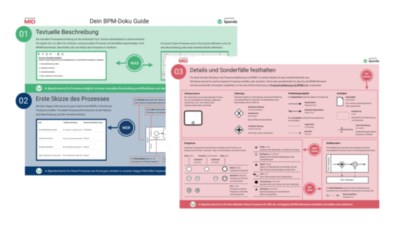
In the training, Wolfgang learns about all the BPMN elements, but is also told that a small set of elements is sufficient for an easy introduction to process documentation. The BPM-Doku Guide “3 Steps to Your BPMN process” provides him with a good overview of the most important BPMN elements for a step-by-step start into the world of process documentation. You too can benefit from our free BPM Docu Guide and download it now!
Wolfgang then sets which BPMN elements he wants to start off using for process documentation in Bpanda and adds this information to the aMIDzon methods manual. He now has everything he needs to get started with the first process interview. The first process is order processing. He invites Oliver and Sophie to the meeting, as they both implement the process on a daily basis. As this will be the first process, he listens enthralled to all the information the various people have to tell and asks a lot of questions about who precisely is responsible for which process steps. At the end of the meeting, he has a pretty good picture of the process. The discussion may have been fairly lengthy, but Wolfgang is sure that things will improve as the next process interviews take place.
Wolfgang then gets to work and uses the Happy Path in Bpanda to lay the groundwork for the order processing process. As soon as he has done this, he opens the process in the Bpanda Modeler and adds start events, end events, gateways, subprocesses and artifacts. The first version of the order processing process is now modeled and Wolfgang uses the Bpanda review feature to gather feedback from his core team, as well as Oliver and Sophie. The result: Oliver comments that a process step is missing and Sophie says that the wrong person in charge has been written at two points. Wolfgang includes this feedback and then: releases the first aMIDzon process!
Click to Zoom
Wolfgang’s Recommendation: Test Bpanda 30 Days for Free and with No Strings attached!
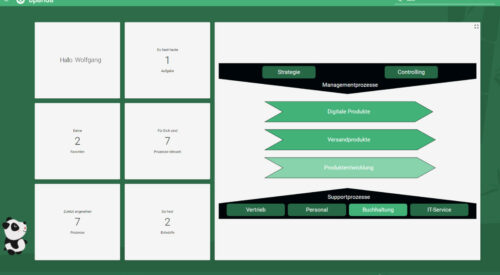
Wolfgang can’t believe how easy it was for him with no previous knowledge of processes to document the first aMIDzon processes. He recommends that you try it yourself in Bpanda!
Try our free 30 day Bpanda trial account. You can use this time to try out all Bpanda functions to their full potential. Try out our Demo model or create your own written processes, use the Happy Path or the BPMN 2.0-compliant Modeler. You can invite up to 5 other people to test the feedback process with you and then use the Jobs feature to run through the process live.

Wolfgang has done it! The first processes are documented in Bpanda and there are plenty more to come. He put all the 6 w’s into practice.
Is process management really a thing of success in aMIDzon now?

What Happens Now that the First Processes Have been Mapped...
Wow! You’ve come a long way on your introduction to process management. Let’s take a look back at everything we’ve learnt: You strategically thought about how to roll out process management and selected a reliable tool and a great team for the job. You tactically defined the process management rules for your company and operatively started mapping your process landscape and documenting the first processes. It was a huge success! But what happens next? How do you make process management part of your daily business? And how can you ensure that your process management plans stay on track and that process documentation is maintained and put into practice?
These are all questions that Wolfgang asked himself too. He knows by now that successful introduction of process management doesn’t simply stop with documented processes. Now the process management starts and processes can also be tweaked and improved. There are many other factors that can also influence how your process management can be successful within your company and stay that way.
Here is a handy list of all of Wolfgang’s tips and suggestions:
You have now heard Wolfgang’s process management story. Hopefully you can also profit from his successes.
We can’t wait to see what your path to a successful process management introduction in your company will look like. Please don’t hesitate to get in touch with us if you would like help getting started at info@bpanda.com!


